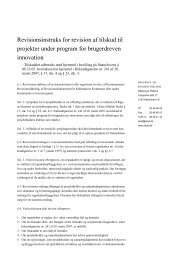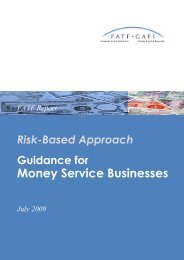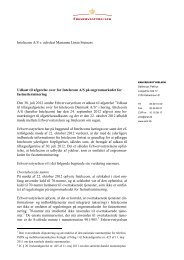Competing in the Single Market - SMEs and ... - Erhvervsstyrelsen
Competing in the Single Market - SMEs and ... - Erhvervsstyrelsen
Competing in the Single Market - SMEs and ... - Erhvervsstyrelsen
You also want an ePaper? Increase the reach of your titles
YUMPU automatically turns print PDFs into web optimized ePapers that Google loves.
The panel identified <strong>the</strong> follow<strong>in</strong>g key challenges for / obstacles to enabl<strong>in</strong>g <strong>the</strong>development of a critical mass of <strong>in</strong>novative <strong>and</strong> <strong>in</strong>ternationally competitive <strong>SMEs</strong>:<strong>SMEs</strong> <strong>and</strong> <strong>the</strong> SME sector are relatively new <strong>and</strong> young <strong>in</strong>stitutions <strong>in</strong> <strong>the</strong> AccessionCountries (<strong>the</strong> New Europe) -> <strong>the</strong> development of a dynamic <strong>in</strong>novative <strong>in</strong>ternationallycompetitive SME sector will take timeOf great importance is chang<strong>in</strong>g <strong>the</strong> attitudes of bureaucrats, policy makers <strong>and</strong>academics re. entrepreneurship <strong>and</strong> <strong>in</strong>novation, but also attitudes to failures <strong>and</strong> <strong>in</strong>centivesfor risk-tak<strong>in</strong>g“(There is) still a push mentality <strong>in</strong>stead of an entrepreneurial pull mentality.”(Marian Geldner)<strong>SMEs</strong> don’t have sufficient access to R&D <strong>and</strong> <strong>in</strong>novative capabilitiesInnovation <strong>and</strong> R&D are concentrated <strong>in</strong> large, foreign-owned firms (particularly <strong>in</strong>new member states); <strong>in</strong>ternationally competitive, <strong>in</strong>novative export-oriented firms areclearly <strong>in</strong> <strong>the</strong> m<strong>in</strong>orityThere is a need to improve cooperation / l<strong>in</strong>kages between government, privatesector <strong>and</strong> academia (triple helix model)“It is important to <strong>in</strong>crease <strong>the</strong> <strong>in</strong>teractions between companies <strong>and</strong> government. Noone <strong>in</strong>stitution is enough by itself.” (Per Eriksson)It is important to <strong>in</strong>crease <strong>in</strong>ternational cooperation among Baltic <strong>and</strong> Nordiccountries <strong>and</strong> <strong>in</strong>crease <strong>the</strong> opportunities for learn<strong>in</strong>g from o<strong>the</strong>rs’ successes <strong>and</strong> failures(policy exchange <strong>and</strong> learn<strong>in</strong>g)“(There are) many programs support<strong>in</strong>g structural reform to support <strong>SMEs</strong>.. BalticSea countries should aspire to be EU leaders <strong>in</strong> policies/activities to support <strong>SMEs</strong>.”(Meelis Atonen)<strong>SMEs</strong> need greater access to f<strong>in</strong>ancial capital: <strong>the</strong>re is a substantial need for capital <strong>in</strong><strong>SMEs</strong> to <strong>in</strong>vest <strong>in</strong> R&D but also to upgrade plant <strong>and</strong> equipment facilities to comply withEU st<strong>and</strong>ards“The #1 problem for start<strong>in</strong>g a bus<strong>in</strong>ess is lack of capital. In Latvia, <strong>the</strong>re arecurrently 17 companies per 1000 <strong>in</strong>habitants; <strong>the</strong> European average is 51 companiesper 1000 <strong>in</strong>habitants.” (Andris Den<strong>in</strong>s)<strong>SMEs</strong> need greater access to human capital (know how, entrepreneurship, etc.).116
















